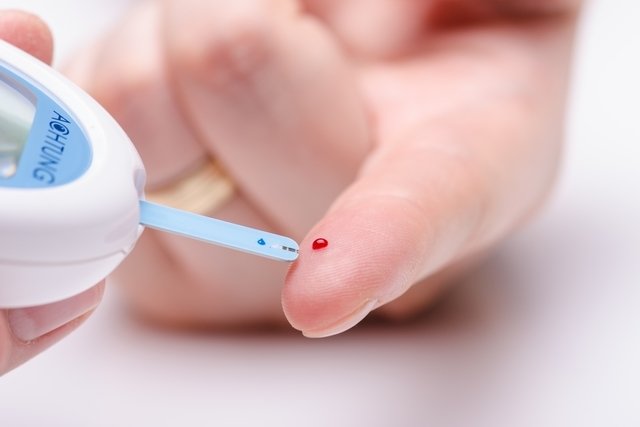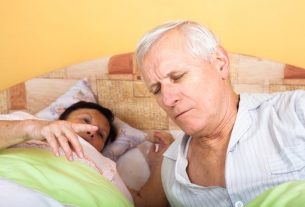Reactive hypoglycemia is when blood glucose levels become very low, about 2 to 5 hours after a meal, causing symptoms such as tremor, excessive sweating and difficulty thinking.
Although the symptoms of reactive hypoglycemia are similar to those of common hypoglycemia, there are tests that can differentiate the two situations, such as glucose measurement and the glycemic curve, which can be indicated to confirm the diagnosis.
If reactive hypoglycemia is suspected, it is important to consult an endocrinologist for a detailed evaluation. When indicated, treatment may involve anything from a diet with less sugar, the use of medication or surgery, in some cases.

Main symptoms
The main symptoms of reactive hypoglycemia are:
- Headache;
- Fome;
- Tremors;
- Nausea;
- Excessive sweating;
- Dizziness;
- Tiredness;
- Drowsiness or agitation;
- Palpitations;
- Difficulty reasoning.
Although these symptoms are the same as those that normally occur in hypoglycemia related to fasting or diabetes, they tend to appear approximately 2 to 5 hours after eating, especially if foods rich in sugar have been consumed. Check out more symptoms and what to do in case of hypoglycemia.
If reactive hypoglycemia is suspected, it is important to consult an endocrinologist for an evaluation and if symptoms such as seizures or fainting occur, it is recommended to seek an emergency room to begin appropriate treatment.
What causes reactive hypoglycemia
Reactive hypoglycemia can be caused by the body’s increased sensitivity to insulin, which can lead to a more pronounced decrease in blood glucose after eating in some people.
However, sometimes reactive hypoglycemia can also be caused by changes that cause an increase in the speed of stomach emptying, as is the case with bariatric surgeries, and/or greater production of hormones that affect blood glucose control, as in case of insulinoma. Understand better what insulinoma is and what its symptoms are.
Furthermore, reactive hypoglycemia can also occur due to an increase in the body’s resistance to the effect of insulin, which can happen in people with type 2 diabetes or prediabetes. Understand better what type 2 diabetes is.
Reactive hypoglycemia and dumping syndrome
Dumping syndrome is a cause of reactive hypoglycemia, which can generally occur after esophageal or stomach surgeries, such as bariatric surgeries, due to changes in the structure of these organs that can lead to the rapid passage of food from the stomach to the intestine. Understand better what Dumping syndrome is.
How to confirm the diagnosis
The diagnosis of reactive hypoglycemia is generally confirmed taking into account the symptoms presented by the person and through blood tests, such as glucose and insulin measurement, preferably carried out at the time the symptoms occur, or a glycemic curve test. See how the glycemic curve test is performed and how to interpret the results.
How the treatment is carried out
Treatment of reactive hypoglycemia depends on its cause and may involve adopting a more balanced diet, with less sugar consumption, and medications, such as acarbose and metformin. In some cases, surgery may be indicated, especially when reactive hypoglycemia is related to bariatric surgery and does not respond well to other treatment measures.
Diet for reactive hypoglycemia
Adopting a balanced diet is an important part of the treatment of reactive hypoglycemia, and it may be recommended to eat smaller meals with 2 to 3 hour intervals between each one to avoid excessive insulin production after eating.
Furthermore, to avoid attacks of reactive hypoglycemia, it is recommended to reduce the consumption of alcoholic beverages and foods rich in sugar, such as pasta, cakes and white bread, giving preference to whole foods, which have a low glycemic index.
Bibliography
- ALTUNTAS, Yuksel. Postprandial Reactive Hypoglycemia. Sisli Etfal Hospital Type Find. Vol.53, n.3. 215–220, 2019
- STATPEARLS. Hypoglycemia. 2022. Available at: <https://www.ncbi.nlm.nih.gov/books/NBK534841/>. Accessed on 06 Sep 2022
- SCARPELLINI, Emidio et al. International consensus on the diagnosis and management of dumping syndrome. Nat Rev Endocrinol. Vol.16, n.8. 448–466, 2020
- GALATI, Sandi-Jo; RAYFIELD, Elliot J. Approach to the patient with postprandial hypoglycemia. Endocr Pract. Vol.20, n.4. 331-340, 2014
- HONKA, Henri; SALEHI, Marzieh. Postprandial hypoglycemia after gastric bypass surgery: from pathogenesis to diagnosis and treatment. Curr Opin Clin Nutr Metab Care. Vol.22, n.4. 295–302, 2019
- BRAZILIAN DIABETES SOCIETY. Postprandial hypoglycemia: problems with diagnosis. Available at: <https://www.diabetes.org.br/publico/notas-e-informacoes/1040-hipoglicemia-pos-prandial-problemas-com-o-diagnostico>. Accessed on 10 December 2019
- HELLER, Simon R. Glucose Concentrations of Less Than 3.0 mmol/L (54 mg/dL) Should Be Reported in Clinical Trials: A Joint Position Statement of the American Diabetes Association and the European Association for the Study of Diabetes. Diabetes Care. Vol 40. 155-157, 2017
- MONGRAW-CHAFFIN, Morgana; BEAVERS, Daniel P.; McCLAINS, Donald A. Hypoglycemic symptoms in the absence of diabetes: Pilot evidence ofclinical hypoglycemia in young women. Journal of Clinical & Translational Endocrinology. Vol 18. 2019




